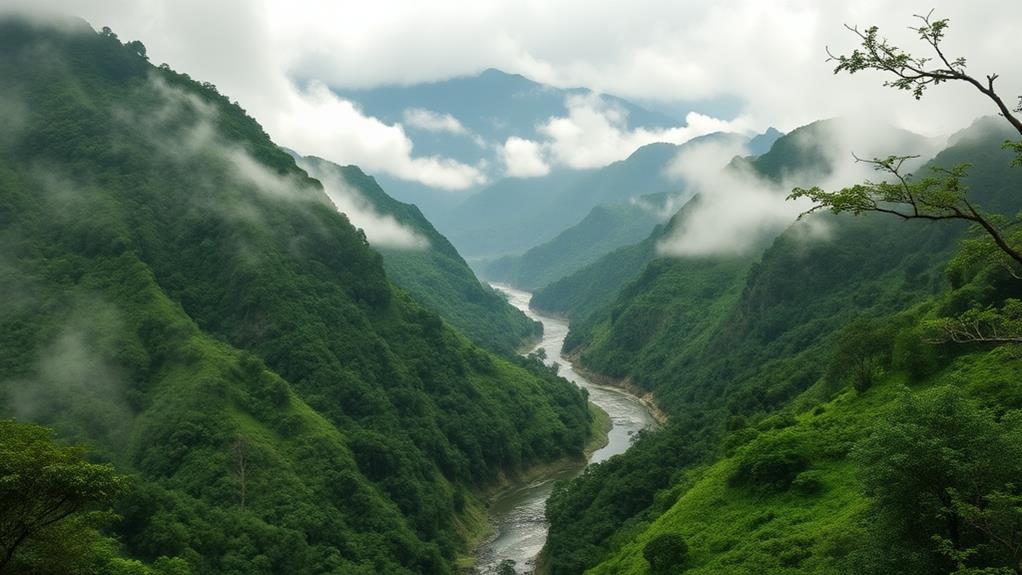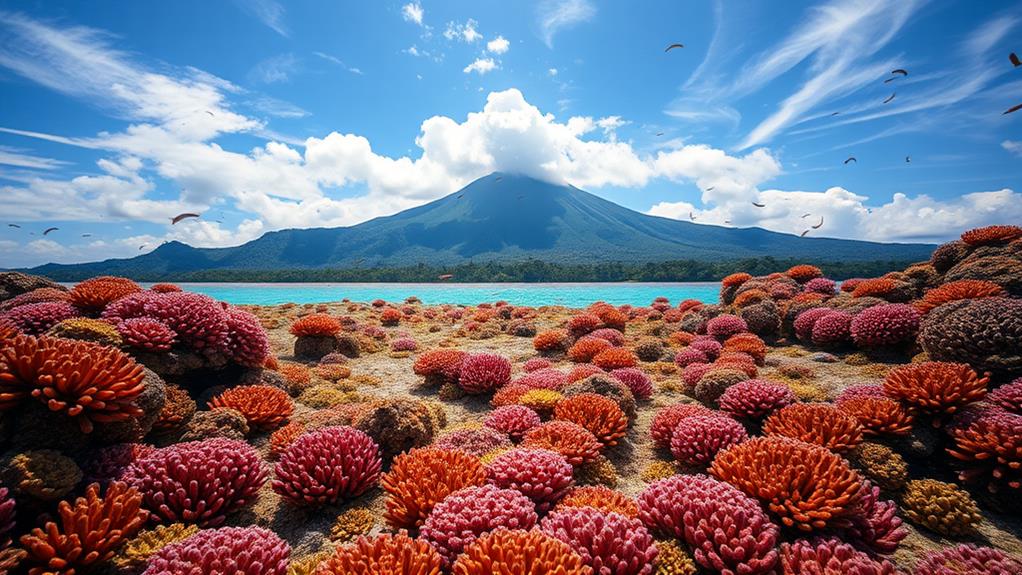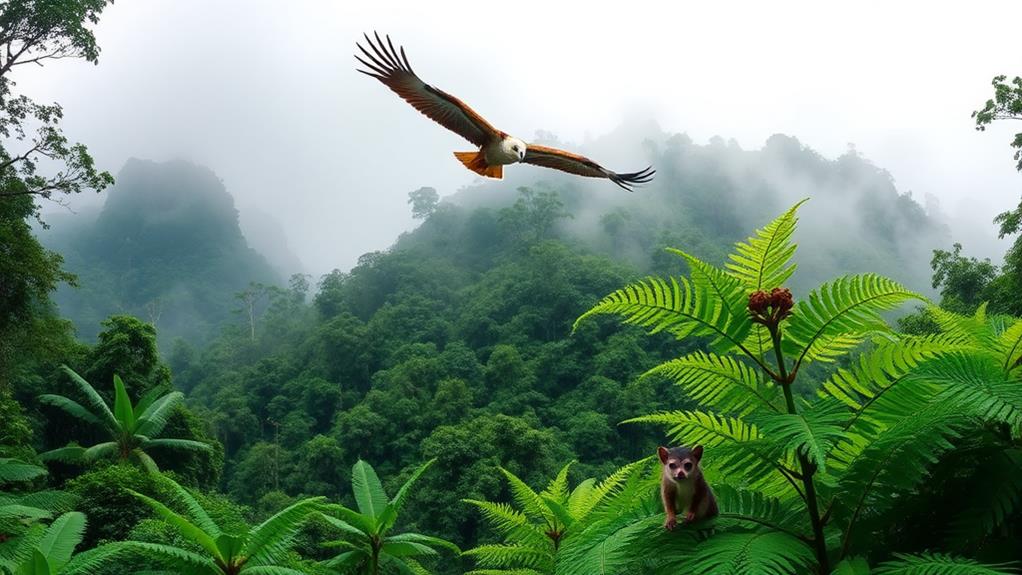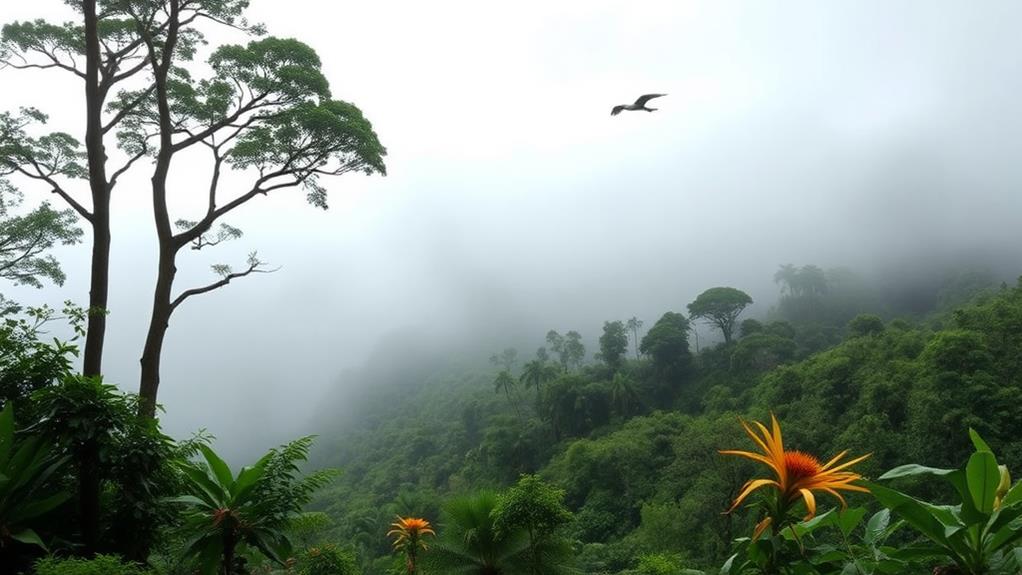Mount Hamiguitan Range Wildlife Sanctuary: A UNESCO World Heritage Site
The Mount Hamiguitan Range Wildlife Sanctuary is a 16,923-hectare protected area in the Philippines, home to five distinct forest ecosystems: dipterocarp, montane, mossy, pygmy forests, and agro-ecosystem.
This biodiversity corridor supports a wide range of species, including critically endangered ones.
1,380 documented species have been found in the sanctuary, with 75% of amphibian species and 84% of reptile species being endemic, meaning they can only be found in this specific region.
The sanctuary's unique ecosystems and species are under threat from environmental factors, and ongoing conservation efforts are in place to protect them.
Geographic and Ecological Overview

Mount Hamiguitan Range Wildlife Sanctuary's Geography
The Mount Hamiguitan Range Wildlife Sanctuary in Eastern Mindanao, Philippines, covers an area of 16,923 hectares with a buffer zone of 9,729 hectares. Its diverse geography features elevations ranging from 75 to 1,637 meters above sea level.
Ecological Significance and Biodiversity
This sanctuary is home to five distinct forest ecosystems: dipterocarp, montane, mossy, and pygmy forests. These ecosystems support a rich biodiversity of endemic and threatened species.
The sanctuary's position within the Eastern Mindanao Biodiversity Corridor provides a habitat for various flora and fauna, including critically endangered species like the Philippine eagle.
UNESCO World Heritage Site and Geological Features
In 2014, Mount Hamiguitan Range Wildlife Sanctuary was inscribed as a UNESCO World Heritage Site, recognizing its outstanding universal value and high levels of endemicity. The sanctuary is home to a diverse range of flora and fauna, with over 1,380 species of flora and 346 species of fauna, many of which are endemic to the area. The recognition as a UNESCO World Heritage Site reflects the importance of preserving the unique and fragile biodiversity in the cordilleras. It also highlights the need for conservation efforts to protect the rich and irreplaceable natural resources found within the sanctuary.
The area's unique geological features, such as ultramafic soils, support rare plant species like pitcher plants of the genus Nepenthes, contributing to its ecological diversity and conservation importance.
Biodiversity and Species Significance
Mount Hamiguitan Range Wildlife Sanctuary: A Treasure Trove of Biodiversity
The Mount Hamiguitan Range Wildlife Sanctuary is home to an astonishing 1,380 documented species, showcasing its exceptional biodiversity. This sanctuary boasts an impressive array of endemic species, including the critically endangered Philippine eagle and Philippine cockatoo, found nowhere else on the planet.
Endemic Species Abundance
Approximately 75% of amphibian species and 84% of reptile species found within the sanctuary are endemic, highlighting the area's exceptional biodiversity.
Unique Ecosystems and Flora
The sanctuary supports five unique ecosystems, including dipterocarp, montane, and mossy-pygmy forests, each hosting a variety of endemic flora and fauna.
Notable plant species include eight pitcher plant species of the genus Nepenthes, exclusively found in the sanctuary, showcasing its unique botanical diversity.
Important Bird Area
As an Important Bird Area recognized by BirdLife International, the sanctuary is a vital habitat for numerous endemic and threatened bird species.
UNESCO World Heritage Site
The Mount Hamiguitan Range Wildlife Sanctuary's incredible biodiversity and species significance solidify its status as a UNESCO World Heritage Site, underscoring the importance of preserving this precious natural asset.
Coral and Marine Ecosystems

Mount Hamiguitan Range Wildlife Sanctuary's Coral and Marine Ecosystems
The Mount Hamiguitan Range Wildlife Sanctuary, situated adjacent to Pujada Bay, is a hotspot within the Coral Triangle, boasting an astonishing array of biodiversity.
Twenty-five genera of hard and soft corals thrive in the area, with an impressive 59.68% coral cover and an average biomass of 33.7 MT/sq km.
This sanctuary supports a diverse range of marine life, serving as a habitat for threatened species such as the whale shark, dugong, and green turtle.
The region is home to diverse fish populations, with approximately 118 fish species documented in a 1000 sqm transect, highlighting its ecological importance for fisheries.
The sanctuary's integrated management approach prioritizes coral reef regeneration and water quality monitoring, ensuring the long-term health of these valuable ecosystems.
Threats and Environmental Challenges
Mount Hamiguitan Range Wildlife Sanctuary's ecosystem is under threat. The sanctuary's coral and marine ecosystems are facing multiple environmental challenges that put their very existence at risk.
Overfishing and coral reef destruction are major threats. These activities have led to a significant decline in marine resources, affecting local fisheries and biodiversity. For example, the destruction of coral reefs has reduced the habitats of many marine species, causing a decline in their populations.
Tourism has contributed to pollution. The influx of tourists has led to an increase in macro and microplastic pollution, posing a threat to marine life and water quality. This is because tourists often litter or dispose of waste improperly, which ends up in the ocean.
Shrimp farms are degrading water quality. Nutrient discharges from Vannamei shrimp farms have degraded water quality, further threatening aquatic ecosystems. This is because the excess nutrients from the farms can lead to algal blooms, which deplete the oxygen in the water, harming marine life.
Mining activities pose a risk. Mining activities upstream risk siltation and heavy metal contamination, which can devastate both terrestrial and aquatic habitats. For instance, siltation can smother coral reefs, while heavy metal contamination can poison marine life.
Climate change is a significant threat. Climate change impacts, including shifting weather patterns and rising temperatures, pose additional risks to the sanctuary's biodiversity and overall ecological integrity. This is because changes in temperature and weather patterns can disrupt the delicate balance of the ecosystem, making it harder for species to adapt and survive.
Conservation efforts are crucial. It's essential to address these environmental challenges to preserve the Mount Hamiguitan Range Wildlife Sanctuary's delicate balance and ensure its continued existence for future generations.
Management, Conservation, and Cultural Significance

The Mount Hamiguitan Range Wildlife Sanctuary's management and conservation rely on a multifaceted approach that combines science, community engagement, and cultural significance.
The sanctuary is governed by the Protected Area Management Board, which prohibits logging, mining, and exploration to ensure its protection.
Collaboration with local and indigenous communities is crucial, as their traditional ecological knowledge and lifestyle rooted in environmental respect enhance conservation efforts.
As a UNESCO World Heritage Site, the sanctuary is home to 341 endemic species, including critically endangered ones like the Philippine Eagle and Philippine Cockatoo. This highlights its critical importance in global biodiversity conservation.
Ongoing management strategies involve monitoring and research programs to address threats such as illegal wildlife collection, mining, and climate change impacts.
Flora and Fauna Diversity
The Mount Hamiguitan Range Wildlife Sanctuary is home to an astonishing 1,380 species of flora and fauna. This sanctuary boasts an impressive level of biodiversity, with 341 endemic species, including the critically endangered Philippine Eagle and the Philippine Cockatoo, highlighting its role in protecting threatened fauna.
The sanctuary supports five distinct forest habitats, including dipterocarp, montane, and mossy forests. Each of these habitats hosts unique flora and fauna adapted to varying elevations. For example, the sanctuary is home to eight endemic pitcher plant species of the genus Nepenthes, which thrive in the sanctuary's unique ultramafic soil conditions.
Approximately 75% of the amphibian species and 84% of the reptile species found in the sanctuary are endemic. This emphasizes the sanctuary's unique ecological significance and its importance as a conservation site.
The Mount Hamiguitan Range Wildlife Sanctuary is a haven for unique flora, with its diverse forest habitats supporting a wide range of plant species. Its ecological significance is undeniable, making it a vital conservation site for the preservation of its rich biodiversity.
Ecosystem Types and Conservation Status

The Mount Hamiguitan Range Wildlife Sanctuary comprises five distinct ecosystem types: agro-ecosystem, dipterocarp forest, montane forest, mossy forest, and mossy-pygmy forest.
Each ecosystem supports unique flora and fauna, providing a habitat for 1,380 documented species, including 341 Philippine endemics.
The sanctuary is home to critically endangered species, such as the Philippine Eagle and Philippine Cockatoo.
It stands out for its high levels of endemicity, with 75% of amphibians and 84% of reptiles found exclusively within the sanctuary's boundaries.
The ecosystems maintain relatively pristine conditions, benefiting from strong legal protection under the National Integrated Protected Areas System (NIPAS).
Ongoing conservation efforts involve collaboration with local and indigenous communities to mitigate threats such as illegal wildlife collection and climate change impacts on the unique habitats.
This integrated approach ensures the long-term preservation of the sanctuary's exceptional biodiversity.
Protection, Management Framework, and Community Engagement
Legal Protection
The Mount Hamiguitan Range Wildlife Sanctuary, as part of the National Integrated Protected Areas System (NIPAS), is legally protected against logging, mining, and exploration within its boundaries to preserve its biodiversity.
Management Framework
The Protected Area Management Board (PAMB) oversees the sanctuary's management, adopting a collaborative approach that involves local and indigenous communities to enhance protection efforts and sustainable resource use.
This approach ensures that local lifestyles align with environmental conservation principles, as demonstrated by the fewer than 100 inhabitants holding tenurial permits in the core and buffer zones.
Management Aspects
Funding Sources: The sanctuary's management is supported by national and provincial government sources, municipalities, and NGOs.
Community Engagement: Local and indigenous communities are involved in management and conservation efforts, ensuring their active participation in preserving the sanctuary's biodiversity.
Conservation Projects: Ongoing projects and research initiatives are facilitated by funding sources, focusing on preserving the sanctuary's rich biodiversity.
Monitoring Programs: Scientific research and monitoring programs are in place to assess species and habitat conditions, providing valuable insights for conservation efforts.
Management Approach: The collaborative approach involving local and indigenous communities has been adopted to ensure the sanctuary's rich biodiversity is preserved for future generations, solidifying its status as a UNESCO World Heritage Site.
What Are the Similarities and Differences Between the Mount Hamiguitan Range Wildlife Sanctuary and the Agusan Marsh Wildlife Sanctuary?
The Mount Hamiguitan Range Wildlife Sanctuary and the agusan marsh wildlife sanctuary both boast diverse ecosystems and unique wildlife. However, the former is known for its unique pygmy forest and high peak, while the latter is famous for its expansive wetlands and bird species. Both sanctuaries offer incredible opportunities for nature enthusiasts to explore and appreciate the beauty of the natural world.
Global Significance and UNESCO World Heritage Status

Mount Hamiguitan Range Wildlife Sanctuary: A UNESCO World Heritage Site
The Mount Hamiguitan Range Wildlife Sanctuary was inscribed as a UNESCO World Heritage Site in 2014, recognizing its exceptional natural importance.
This prestigious designation underscores its outstanding universal value as a biodiversity hotspot, with 341 Philippine endemics among its 1,380 documented species.
Key aspects contributing to its global significance:
Its classification as an Important Bird Area (IBA) by BirdLife International emphasizes its importance for conservation efforts, particularly for endangered species like the Philippine Eagle and Philippine Cockatoo.
Unique ecosystems, including mossy and pygmy forests, harbor rare flora and fauna, making it a significant site for ecological studies.
Legal protection under the National Integrated Protected Areas System (NIPAS) ensures ongoing conservation efforts to safeguard its rich biodiversity against threats like mining and climate change.
Exploring the Sanctuary
The Mount Hamiguitan Range Wildlife Sanctuary offers a complete and diverse mountain ecosystem in Eastern Mindanao, with opportunities for scientific research, conservation, and community engagement.
Frequently Asked Questions
What Is the Problem With Mount Hamiguitan Range Wildlife Sanctuary?
Mount Hamiguitan Range Wildlife Sanctuary faces a severe threat from ecosystem degradation.
The main causes of this degradation are deforestation and illegal logging, which lead to habitat loss. For instance, the clearing of forests for agriculture and urbanization has resulted in the destruction of natural habitats, leaving many species without a place to live.
Climate change is also exacerbating biodiversity threats by altering the delicate balance of the ecosystem. Rising temperatures and changing weather patterns disrupt the natural habits and habitats of the species that inhabit the sanctuary.
Human activities, such as poaching and uncontrolled tourism, further strain the environment. Poachers hunt endangered species, reducing their populations and disrupting the food chain.
Uncontrolled tourism leads to litter, noise pollution, and the destruction of habitats, causing stress to the animals and altering their behavior.
Invasive species also pose a significant threat, as they compete with native species for resources and habitat, leading to a decline in native species populations.
To combat these issues, conservation efforts must be boosted. This can be achieved by engaging local communities in conservation initiatives, providing them with education and resources to manage the sanctuary sustainably.
Securing funding is also crucial for effective management and biodiversity monitoring, allowing conservationists to track the health of the ecosystem and respond to threats promptly.
A collaborative and sustainable approach is necessary to protect the Mount Hamiguitan Range Wildlife Sanctuary.
What Is There to Do at Mount Hamiguitan Range Wildlife Sanctuary?
Explore Nature's Wonders at Mount Hamiguitan Range Wildlife Sanctuary
Mount Hamiguitan Range Wildlife Sanctuary offers a variety of activities to connect with nature.
Hike through diverse ecosystems on well-marked trails, where you can spot unique wildlife and endemic species. For a more in-depth experience, join guided eco-tours that provide insights into the sanctuary's natural treasures.
If you prefer to venture out on your own, bird watching and photography are excellent ways to appreciate the sanctuary's beauty. Take in the breathtaking scenic viewpoints that showcase the area's natural splendor.
Deepen Your Understanding of the Local Culture and Environment
The sanctuary offers educational programs that focus on conservation efforts, allowing you to gain a deeper appreciation for the local culture and environment.
These programs provide a unique opportunity to learn about the importance of preserving the sanctuary's natural resources.
Unwind in Nature's Serenity
After a day of exploring, unwind at one of the camping sites, immersing yourself in the natural beauty of this protected area.
This allows you to recharge and reflect on the unforgettable experiences you've had at Mount Hamiguitan Range Wildlife Sanctuary.
What Can You Say About MT Hamiguitan?
Mt. Hamiguitan is a biodiversity hotspot. This mountain is home to endemic species like the Philippine eagle and cockatoo, which can only be found in this region.
Conservation efforts prioritize eco-tourism potential, cultural heritage, and community involvement. This means that protecting the environment goes hand-in-hand with promoting responsible tourism, preserving local culture, and involving the community in decision-making.
Research opportunities abound on Mt. Hamiguitan. Scientists focus on climate impact, studying how changes in temperature and weather patterns affect the ecosystem.
They also investigate ecological balance, examining how living organisms interact with their environment. Additionally, environmental education is a key area of research, aiming to teach people about the importance of conservation.
How Many Unesco World Heritage Sites Are in Danger?
53 UNESCO World Heritage Sites are in danger as of 2023. These sites face threats from biodiversity loss, armed conflict, and human activities.
UNESCO evaluates the condition of these sites and the efforts being made to conserve them. The "in danger" designation aims to raise global awareness and mobilize international support for heritage management and site preservation.
Community involvement is crucial in addressing the cultural significance of these sites and promoting effective conservation efforts.
For example, the ancient city of Palmyra in Syria is a World Heritage Site in danger due to armed conflict. Similarly, the Rainforests of the Atsinanana in Madagascar are threatened by biodiversity loss.